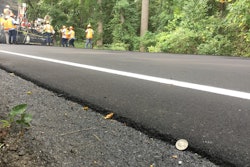
As owners are continually trying to do more with less money, contractors are faced with the challenge to move away from new construction and shift towards cost-effective pavement preservation.
This is not a new phenomenon. You’ve been preaching pavement preservation to your customers from day one as a means to extend the life of their asphalt investments. Preservation treatments should correct cracking, rutting and raveling. These treatments should also seal the surface to prevent intrusion of water and air.
But the most important quality of a preservation treatment is that it needs to last. Long life allows the pavement manager to lower life cycle costs and optimize the performance of the entire pavement network.
However, most preservation treatments can only do so much. They do not add structural life to the pavement and once the pavement begins to fail beneath the surface, your customer is in trouble.
Enter the age of the overlay: Placing asphalt over what’s already on the ground to correct surface problems, add structural life and preserve the pavement.
“Pavements often fail because of cracking that starts at the bottom of the pavement layer," says John Hickey from the Asphalt Pavement Association of Oregon. "That cracking works its way to the surface over time, which results in structural failure. If you increase the thickness of the pavement layer, the stresses at the bottom of the layer will be less. Increase the thickness enough and the stresses will be small enough that they won’t cause cracking at the bottom. The result is a perpetual pavement that will never fail from the bottom up.”
Thin asphalt overlays designed specifically for preservation, better known in the industry as Thinlays, can be used to build a perpetual pavement 1 in. at a time, adding structural life with each inch.
Most customers saw overlays as too costly of a pavement preservation treatment, so the industry began developing overlays that were thinner and more economical.
When to Use a Thinlay
Thinlay treatments are meant to preserve pavements in fair to good condition, and timely application is the key to optimal success. According to pavement design principles, adding a 1-in. overlay on an existing 4-in. pavement designed for 20 years, can double the fatigue life.
The principles also show that a second 1-in. overlay placed on top of the first can double the fatigue life again, extending the fatigue life of the pavement to significantly more than 50 years.
“This holds true only IF the overlay is done IN TIME, meaning the structural integrity of the pavement has not reached a point where it is compromised beyond help,” Hickey says.
This means there are certain situations that prove better for Thinlays than others. A pavement is a candidate for a Thinlay if it has:
- A raveling chip or seal or a worn slurry seal
- Minor longitudinal/transverse cracking
- Shallow rutting ≤ 0.5-in.
- Top-down cracking
- Block cracking (must seal first)
- Less than 20% moderate fatigue cracking (spot repair prior to Thinlay)
- Limited vertical clearance or curb reveal
Before completing a Thinlay, the area must have a stable foundation. If there is poor drainage, those areas need to be addressed before paving.
As with any preservation treatment, the surface must be clear of dirt and silt before application. A uniform tack coat must also be applied as it is essential for helping to create a bond between the existing surface and the newly applied asphalt surface.
If the existing surface is near the upper limits for cracking and rutting, milling may be required to achieve a uniform surface for the Thinlay to be placed on.
Paving a Thinlay can also be tricky as cooling can be an issue. Pavements become more difficult to compact as they cool and the paver can move quicker with thinner lifts. According to NAPA, 1-in. of asphalt cools two times faster than a lift that’s 1.5-in. For thinner lifts, they recommend making sure the contractor has enough rollers to keep up with the paver.
"Thinlays will cool faster than a thick pavement layer, which means you need to have rollers right behind the paver," Hickey says. "The bottom line is that once the pavement is on the ground, there needs to be enough rollers to keep up with the paver."
Hickey says warm mix technology can also be used to help with compaction.
During compaction, do not use your roller on vibratory mode if the lift is less than 1-in.
NAPA cautions that customers should have realistic expectations when it comes to Thinlays. Only a 40-60% improvement in ride-quality can be expected.
"Thinlays may provide only a 40-60 percent improvement in ride quality, but that is compared to a 0 percent improvement in ride quality with other preservation treatments," Hickey says. "Although not as perfect as a complete reconstruction, these treatments are much better than other preservation treatments."
What to Mix
The mix designs for Thinlay applications are made specifically for pavement preservation. Aggregate gradations allow placement as thin as ¾-in. in these applications. Binders and gradations are selected to optimize flexibility, durability and rut resistance.
The Thinlay mix design criteria for preservation are generally:
- Nominal max aggregate design =/< 1/3 lift thickness (for ¾-in. lift use ¼-in. or smaller mix)
- Binder selected to optimize crack resistance (softest binder that passes rut test), polymers for highest demand areas
- RAP and RAS combined with softer base binders to provide optimum value
- Va (3.5-4%), VMA (15-17), Binder Replacement (35% max), avoid low VMA high dust mixes
- RAS (5% max)
Research has shown that the finer gradations used in Thinlays are resistant to rutting and result in an impermeable pavement surface, which reduces the need to seal a Thinlay.
To keep costs down even further for customers, these mix designs can include recycled asphalt pavement (RAP) and recycled asphalt shingles (RAS).
NCAT and NAPA conducted research to develop high performance and high recycle content Thinlay mixes. These mixes were designed to be placed as thin as ¾-in., provide excellent crack resistance and maximize recycle content.
Softer binders were used to improve crack resistance and to offset the stiffening effects of the RAP/RAS. They found that softer binders in conjunction with higher RAP/RAS ensures rut resistance and durability.
"In fact, using the softer binders with higher RAP/RAS contents produced mixes with better durability in lab tests than the control mixes," Hickey says.
Thinlays share many of the benefits seen in overlays and inlays: extended pavement life, smooth ride, an improvement in pavement strength, enhanced safety and responsible use of natural resources through reuse and recycling. However, be sure to evaluate the job at hand prior to recommending a Thinlay to your customer and, as with any preservation treatment, be sure they understand what a realistic result will be for the Thinlay.




















